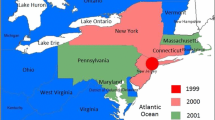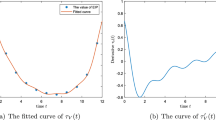Abstract
A reaction–diffusion model for the spatial spread of West Nile virus is developed and analysed. Infection dynamics are based on a modified version of a model for cross infection between birds and mosquitoes (Wonham et al., 2004, An epidemiological model for West-Nile virus: Invasion analysis and control application. Proc. R. Soc. Lond. B 271), and diffusion terms describe movement of birds and mosquitoes. Working with a simplified version of the model, the cooperative nature of cross-infection dynamics is utilized to prove the existence of traveling waves and to calculate the spatial spread rate of infection. Comparison theorem results are used to show that the spread rate of the simplified model may provide an upper bound for the spread rate of a more realistic and complex version of the model.
Similar content being viewed by others
References
Hadeler, K., Lewis, M., 2002. Spatial dynamics of the diffusive logistic equation with a sedentary compartment. CAMQ 10, 473–499.
Komar, N., Langevin, S., Hinten, S., Nemeth, N., Edwards, E., Hettler, D., Davis, B., Bowen, R., Bunning, M., 2003. Experimental Infection of North American birds with the New York 1999 strain of West Nile virus. Emerg. Inform. Dis. 93, 311–322.
Lewis, M., Li, B., Weinberger, H., 2002. Spreading speed and linear determinacy for two species competition models. J. Math. Biol. 45, 219–233.
Li, B., Weinberger, H., Lewis, M., in press. Spreading speeds as slowest wave speeds for cooperative systems. Math. Biosci.
Lu, G., Sleeman, B.D., 1993. Maximum principles and comparison theorems for semilinear parabolic systems and their applications. Proc. R. Soc. Edinburgh A 123, 857–885.
Lui, R., 1989a. Biological growth and spread modeled by system of recursions. I. Math. Theor. Math. Biosci. 93, 269–295.
Lui, R., 1989b. Biological growth and spread modeled by system of recursions. II. Biological theory. Math. Biosci. 93, 297–312.
Okubo, A., 1998. Diffusion-type models for avian range expansion. In: Henri Quellet, I. (Ed.), Acta XIX Congressus Internationalis Ornithologici. National Museum of Natural Sciences, University of Ottawa Press, pp. 1038–1049.
Smoller, J., 1983. Shock Waves and Reaction-Diffusion Systems. Springer-Verlag, New York.
van den Driessche, P., Watmough, J., 2002. Reproduction numbers and sub-threshold endemic equilibria for compartmental models of disease transmission. Math. Biosci. 180, 29–48.
Volpert, A.I., Volpert, V.A., Volpert, V.A., 1994. Traveling Wave Solutions of Parabolic Systems, Vol. 140. American Mathematical Society, Providence, RI.
Weinberger, H., Lewis, M., Li, B., 2002. Analysis of linear determinacy for spread in cooperative models. J. Math. Biol. 45, 183–218.
Wonham, M.J., de Camino-Beck, T., Lewis, M., 2004. An epidemiological model for West-Nile virus: Invasion analysis and control application. Proc. R. Soc. Lond. B 271, 501–507.
Author information
Authors and Affiliations
Corresponding author
Rights and permissions
About this article
Cite this article
Lewis, M., Rencławowicz, J. & den Driessche, P.v. Traveling Waves and Spread Rates for a West Nile Virus Model. Bltn. Mathcal. Biology 68, 3–23 (2006). https://doi.org/10.1007/s11538-005-9018-z
Received:
Accepted:
Published:
Issue Date:
DOI: https://doi.org/10.1007/s11538-005-9018-z




